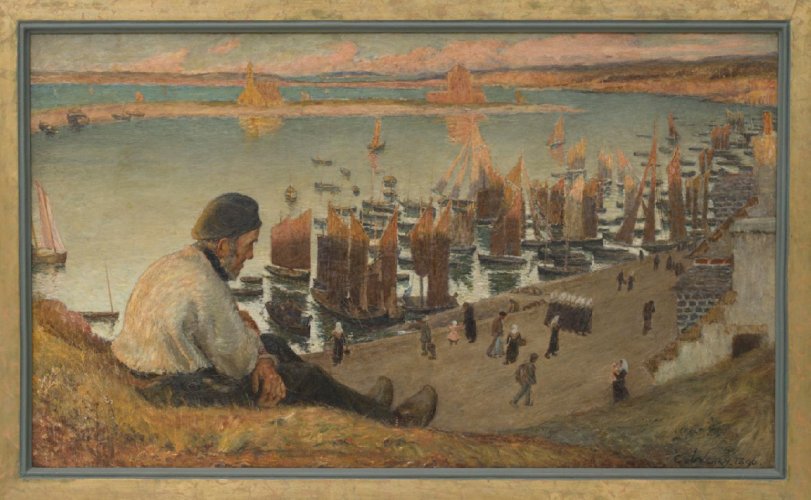Description:
Emile Auguste Wéry (1868 – 1935) was a French artist who graduated from the Académie Julian in Paris. For years he was friends with Henri Matisse, with whom he occupied neighboring studios in Paris in the 1890s. He regularly exhibited his works, including at the Salon des Artistes Français, where he was awarded. He created in the Naturalism movement, inspired by Impressionism. He mainly depicted Breton views.*
Description of the painting:
In addition to painting Breton themes, for which he became famous, the artist also immortalized genre scenes taking place in Dutch villages. The painting depicts a characteristic Dutch canal landscape. The thoughtful figure in the boat reminds us of the monotony and grayness of everyday life, which is brightened by nature. The theme of the work fits into the tendency of searching for harmony with nature that appeared at the turn of the 19th and 20th centuries.
Moving along the coast of Brittany, we reach the small port of Camaret-sur-Mer (Breton Kameled) in the department of Finistère. In the Belle Epoque, this was a favorite place for rest and work of Parisian intellectuals and painters, including Charles Cottet, but also Émile Wéry.
After studying at the Paris Académie Julian, Wéry became friends with Henri Matisse, with whom they had neighboring studios on the Boulevard Montparnasse. In the spring of 1896 they went to Brittany, which became the main theme of Wery’s paintings at the end of the 90s of the 19th century. Among them, the leading position is occupied by “The Last Glows”, which were exhibited at the Salon Société des Artistes Français in 1897, and then chosen for a retrospective exhibition as part of the Universal Exhibition in Paris in 1900. From there, they surely went to the collection of Edward Alexander Raczyński, and later to the second hall of the Rogaliński Gallery, where you can still see them today.
The artist also practiced mural painting, although he is most valued for his Breton works. In 1906 he was appointed a knight of the Legion of Honor. Unlike Matisse, who followed the path of expressive colorism, Wéry remained faithful to his naturalism, which over time turned into a style of decorative fantasy, which owed much to Impressionism.
Just as Cottet’s four-year-earlier painting “Sails at Sunset” from the Hermain Gallery, Wéry’s painting also shows the characteristic view of Camaret with the so-called “Golden Tower”, which is part of the historical “Fortifications of Vauban” from the 17th century. Together with the neighboring chapel Notre-Dame-de-Rocamadour, it is located on a narrow spit called “Sillon”, which protects the entrance to the port.
Unlike Cottet’s painting, Wéry shows us the port from a higher perspective, so we can almost see it in its entirety. The center of the composition is occupied by numerous boats with sails bathed in the setting sun. It is closed by the “Sillon” spit visible in the distance. All this scenery serves as a background for the figure of an old fisherman immersed in melancholy contemplation, which we can see in the foreground. Raised above the daily port life, he looks at it with distance, from the perspective of the approaching, inevitable end. The titular last glows serve a double role here, giving the painting a deep symbolic meaning. Referring to old age and the inevitable transience of human life, it inserts it into the eternal, cosmic rhythm, which gives it meaning through its connection with the all-encompassing nature of an almost sacred dimension, emphasized by the extraordinary, golden light of the setting sun.


